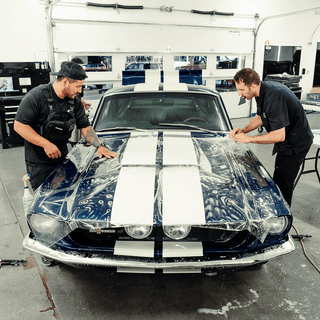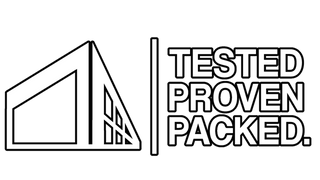
Can PPF Really Protect Your Car's Paint?
Okay, so you’ve probably heard a lot about PPF (paint protection film) and are curious about what it’s all about. Well, you’re in the right place because I’m going to talk you through why it’s gaining so much popularity and why so many people are getting it installed on their car’s paint. Car protection film commonly known as PPF, paint protection film, or clear bra, is like a huge screen protector but for your vehicle. Picture it as an invisible armor, guarding your car against scratches, swirl marks, and even those pesky rock chips that seem to come out of nowhere.
This high-tech film is designed to take the hits so your car’s paint doesn’t have to. It acts as a bodyguard, absorbing the impact of everyday hazards that can wreak havoc on your car’s paint. Whether it’s road debris, stray stones, or the occasional love tap from shopping carts, PPF acts as a sacrificial layer, preventing these nuisances from leaving their mark on your car.
The History Behind PPF (Paint Protection Film)
Get ready because it’s story time with Jason. It all began in the Vietnam War (yes, you read that right)! In the mid-1950s, the US military faced a major headache: helicopter rotor blades getting shredded by flying debris during landing and takeoff. Replacing them was costly and time-consuming, so they needed a solution. Enter 3M, the innovative company that brought us sticky notes and magic Scotch tape. They developed a thin, transparent film – the original "helicopter tape" – made from thermoplastic urethane, that could be applied to the blades for protection. It worked like a charm, reducing damage and saving the military big bucks.
Fast forward a few decades, and "helicopter tape" found its way into the world of skiing. Skiers and snowboarders discovered its potential for protecting their boards from scratches and dings, leading to the catchy name "Ski Saver." It was around this time that PPF also started creeping into the automotive industry. High-end racing teams adopted it to shield their precious race cars from track debris and close-quarter clashes.
The 1990s saw PPF gain broader popularity among automotive enthusiasts, particularly for protecting vulnerable areas like headlights and bumpers. As technology advanced and the film became more user-friendly, it finally reached the mainstream market in the early 2000s. Today, PPF is a popular choice for car owners of all levels, offering a range of benefits beyond just scratch protection. It can:
- Prevent swirl marks and fading caused by sun exposure
- Resist chemical damage from bird droppings and salt spray
- Self-heal minor scratches with heat
- Increase your car's resale value
These are some of the key benefits to having paint protection film on your car. I’ll probably never not have it on any of my personal vehicles.
Oh, and thank you for staying attentive during my history lesson on PPF.
How Does PPF Work?
Great question. Let’s talk about the science behind it.
PPF is like a transparent shield—think of it as a thin, durable layer that wraps your car in invisible armor. When it comes to battling scratches, swirl marks, or those sneaky rock chips, PPF steps up to take the hits, so your paint job doesn’t have to suffer.
The secret sauce? It’s made of high-quality polymers that have a knack for absorbing impact. So, when a pebble tries to leave its mark on your car’s pristine paint, PPF jumps in and absorbs the impact without leaving a trace behind.
Here’s the beauty of it: PPF works its magic without stealing the spotlight. It’s crystal clear, allowing your car’s paint to shine through, maintaining that showroom-worthy finish while quietly doing its job in the background. If you decide you want to change up the aesthetics a bit, there are different variations of the film, like gloss black, matte black, flatte matte, and frozen matte. We carry these different films with our Opticle Defense line.
Think of PPF as a trusty bodyguard—always on duty, always protecting your car’s paint. The only thing it doesn’t protect against are heavy impact accidents. However, if you happen to get in an accident with PPF film on your car, you’re insurance company will cover the cost of having it replaced. I guess there’s an upside there.
Full Coverage vs. Partial Coverage
The real question here is, how much are you willing to pay? No, but seriously. In an ideal situation, you’d want to PPF your entire vehicle. Why? Well, even though only certain parts of your car are considered high impact areas (front bumper, hood, mirror caps, roof), if you only do a partial coverage, you still have the rest of the vehicle that exposed. It’s not a bad thing if you only do partial coverage because something is better than nothing, but keep in mind that the rest of your vehicle is susceptible to damage over time.
The best installers near you will more than likely suggest you PPF your entire car and I so would I. But, let’s look into the pro and cons of full coverage vs. partial coverage.
Full Coverage
Pros:
- Comprehensive Protection: Full coverage PPF shields the entire painted surface of your car, offering complete protection against scratches, chips, and environmental damage.
- Preserves Resale Value: By safeguarding the entire paint job, full coverage PPF helps maintain the car's original paint condition, potentially increasing its resale value.
- Uniform Appearance: Provides a seamless look across the entire vehicle, ensuring consistency in protection and appearance.
- Ease of Maintenance: Simplifies cleaning routines as the entire surface is protected, reducing the risk of dirt and grime buildup on unprotected areas.
- Peace of Mind: Offers peace of mind to owners, knowing that the entire car is shielded from various road hazards and minor accidents.
- Even Wear: If you only apply it to some panels then the panels without PPF will wear differently and there can be noticeable discoloration. This is due to the extra UV protection provided by the PPF. An alternative is to ceramic coat the panels that do not have PPF. While ceramic coatings will not protect like PPF it does provide UV protection and can aid with the wear.
Cons:
- Higher Cost: Full coverage PPF involves more material and labor, making it more expensive than partial coverage or spot applications.
- Installation Challenges: The complexity of applying PPF to the entire vehicle requires skilled professionals and errors during installation can be costly to rectify.
- Maintenance and Replacement: Over time, the film might show wear, and replacing the entire PPF can be pricey. Maintaining a uniform appearance might require replacing the entire film if damage occurs.
- Potential Yellowing: Some lower-quality PPFs may experience discoloration or yellowing over time due to exposure to sunlight and environmental factors.
Partial Coverage
Pros:
- Cost-Effective: Partial coverage PPF is generally less expensive than full coverage, making it more budget-friendly for vehicle owners.
- Targeted Protection: Focuses protection on specific vulnerable areas prone to damage, such as the front bumper, hood, side mirrors, or door edges.
- Easier Installation: Applying PPF to specific sections requires less time and labor compared to full coverage, potentially reducing installation costs.
- Aesthetic Appeal: When applied strategically, partial coverage can provide protection while maintaining the original look of the car without altering the entire paint surface.
- Versatility: Allows customization based on the owner's preferences and the areas they deem most susceptible to damage.
Cons:
- Incomplete Protection: Leaves unprotected areas vulnerable to scratches, chips, and other damage, potentially resulting in uneven wear on the paint job.
- Potential Visual Discrepancies: The difference between protected and unprotected areas might become noticeable over time, affecting the overall aesthetic appeal.
- Maintenance Challenges: Cleaning and maintaining different sections of the car with varying protection levels may require more attention to prevent inconsistencies in appearance.
- Future Damage Risk: Areas without protection remain susceptible to damage, necessitating potential future repairs or refinishing work.
- Resale Value Impact: In some cases, partial coverage may not offer the same perceived value as full coverage PPF when selling the vehicle.
Is Paint Protection Film Expensive?
The cost of paint protection film for cars can vary widely based on multiple factors such as the size of the vehicle, the brand and quality of the film, and whether you opt for partial or full coverage. Typically, the cost of a complete vehicle installation of full coverage paint protection film falls within the range of $7,000 to $9,000, and for reputable shops known for top-notch (world-class) service, the expenses may go even higher. On the flip side, opting for partial coverage, concentrating on susceptible regions such as the front bumper or hood, tends to be more economical, often ranging from a few hundred to a couple thousand dollars.
On the other hand, a ceramic coating, while typically less expensive than PPF, offers a different level of protection. It involves applying a liquid polymer that bonds with the vehicle's paint, providing a durable and hydrophobic layer that enhances shine and repels dirt and water. While ceramic coating is a more cost-effective option, it doesn’t offer the same level of physical protection against scratches and chips that PPF provides. It’s more about maintaining the paint’s appearance and ease of cleaning rather than creating a physical barrier against damage.
PPF’ing My Car - Is It Worth It?
In the grand game of keeping your car looking pristine, paint protection film (PPF) stands tall as the ultimate defender. It’s a shield against the everyday battles your car faces on the road. From annoying pebbles to parking lot mishaps, PPF steps up, taking the hits so your paint job doesn’t have to bear the scars. Sure, it's an investment, but when you weigh the cost against the peace of mind and the prolonged beauty of your car’s paint job, it's a no-brainer. If you can swing it, PPF is your ticket to a paint job that looks fresh off the lot for longer, ensuring your car stays sleek and protected, mile after mile. So, when it comes to safeguarding your four-wheeled pride and joy, if you can afford the added layer of defense, PPF is the ace up your sleeve, ensuring your car stays a head-turner for years to come.
Oh, and bonus… if you want to see me attempting to be a PPF installer with E.MAN (master PPF installer), check out this episode from our Auto Detailing Shop Life.

